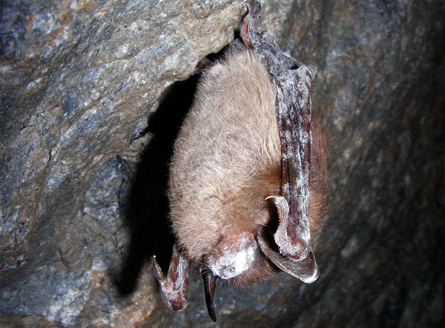A novel disease could kill off the Northeastern population of the little brown myotis bat, a once-common fixture of summer nights, in as little as 16 years.

That’s the worst case from the first analysis of what white-nose syndrome could do to the region’s bat population, ecologists report in the Aug. 6 Science. First seen in North America in 2006, the disease is now killing Northeastern brown myotis bats at an overall average rate of 73 percent annually.
Mortality from emerging diseases does sometimes drop after the initial killing spree picks off weaker individuals, leaving hardier animals behind, says lead author Winifred F. Frick of Boston University and the University of California, Santa Cruz. And diseases may also spread more slowly as a population thins.
Plenty of diseases don’t slow down though, Frick says. And for the little brown myotis to have a decent chance of persisting through the next century in the Northeast, mortality rates would have to drop a lot — at least down to 5 percent per year, Frick and her colleagues have calculated. The researchers do not yet know how populations of the bat might fare elsewhere in its range, which extends across the United States and into Canada and Mexico.
Five other hibernating bat species live in the Northeast too. Though researchers haven’t analyzed their population trends, these species are also susceptible to white-nose syndrome.
“We’re in the middle of a terrible, natural experiment to see how important bats are to the ecosystem,” Frick says. Little brown myotis, formerly known as the little brown bat, hunts insects that include some crop pests and a share of mosquitoes.
White-nose syndrome has been known in North America only since 2006, when a caver photographed bats in New York with weird white fuzz on their noses.
That fuzz increasingly looks like the cause of the disease, according to Frick. Infected bats develop lesions on their wings and rouse from hibernation too often and too early, possibly starving to death from burning through their fat reserves too fast.
So far white-nose syndrome has shown up in nine bat species and swept into 14 states, including Tennessee and Oklahoma, and two Canadian provinces.
“It’s scary as hell,” says Nina Fascione, Washington, D.C.–based executive director of Bat Conservation International.
So far there’s no preventive or cure, and an attempt to set up a captive breeding colony of at-risk species has failed, she says. But biologists are straining their creativity, contemplating creating heated refuges in caves, for example. “There are suggestions for combating the disease that in other circumstances would sound insane,” Facsione says.
Wildlife managers in states not yet affected are trying to reduce risks, for example by trying to keep caving gear that has been used in the East from getting near a western cave. “I can tell you that bat researchers in the West are very concerned,” says wildlife geneticist Toni Piaggio of the National Wildlife Research Center in Fort Collins, Colo.
Disease spread might be slower in the West, where small hibernating roosts scatter over vast and varied landscapes, speculates Pat Ormsbee of Eugene, Ore., a bat specialist for the U.S. Forest Service and Bureau of Land Management.
“My favorite fantasy,” Ormsbee says, “is that western bats are in these smaller winter colonies because they have been faced with a similar malady in the past and will be able to withstand white-nose syndromes more successfully then have eastern bats.”






